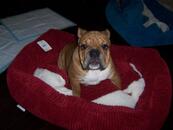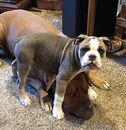by Staff Sgt. Robert M. Trujillo
9th Reconnaissance Wing Public Affairs
BEALE AIR FORCE BASE, Calif. -- During World War I tales of sacrifice and heroism emerged from battlefield. These heroes came from all walks of life; one such hero happened to walk on all fours.
He was a bulldog named Sgt. Stubby.
He served in 17 battles and fought in four major allied offensives with Beale's 1st Reconnaissance Squadron, 12th RS and 99th RS, which provided air support.
Sgt. Stubby became the most decorated war dog in WWI and the first dog to be given a rank by the U.S. Armed Forces. But, Stubby wasn't a military working dog. He was a stray.
His humble beginning started in the fields of Yale University in 1917. The puppy found his way to the care of Pvt. Robert Conroy who named stubby after his short tail.
Conroy was at Yale training with the 102nd Infantry, 26th "Yankee" Division to deploy to Europe to fight in WWI.
While under the care of Conroy, the pup learned bugle calls and how to drill in formation. Stubby even performed a modified salute where he put his right paw over his eyebrow. His antics had a very positive effect on morale, and he was even allowed to stay at the camp although animals were forbidden.
When Conroy's unit was sent to France he smuggled Stubby aboard the ship. Once in France, Conroy's commanding officer discovered Stubby but was won over by the dog's ability to salute and allowed Stubby to stay with the unit.
The 102nd Infantry reached the French front lines in February 1918. The dog was given special orders to stay with the unit as its official mascot.
During his 18-month tenure with the 102nd Infantry, Stubby became accustomed to the sound of rifles and artillery. He also developed a keen sense for gas after surviving a gas attack. Stubby used this skill to warn the 102nd during an early morning gas attack when most of the troops were sleeping. He ran through trenches barking and biting soldiers until they donned their gas masks.
The dog was also credited with locating wounded American soldiers between the trenches of opposing armies. He would listen for English cries of help, run to their source and lead the wounded back to safety. If the men could not move, Stubby stayed with them and barked until helped arrived.
Stubby earned a promotion by capturing a German spy who was mapping the layout of allied trenches. Stubby recognized the intruder and bit and held him until friendly forces arrived. For this action, the 102nd commander promoted Stubby to the rank of sergeant.
Near the end of his deployment Sgt. Stubby was wounded by a grenade, taking shrapnel to his chest and legs. He was taken to a Red Cross field hospital where he was nursed back to health.
By the end of the war, the stray dog from Connecticut was awarded many medals for heroism and bravery.
Notable awards included:
Three service stripes
French Medal Battle of Verdun
Republic of France Grande Medal
St. Mihiel Campaign Medal
Purple Heart
Chateau Thierry Campaign Medal
New Haven WWI Veterans Medal
He was also awarded a Gold Hero Dog Medal from the Humane Society, which was presented by Gen. John Pershing, commanding general of the U. S. Armies.
Stubby came home from the war to a hero's welcome, he marched in parades and was made a lifetime member of the American Legion and YMCA. He would later meet presidents Woodrow Wilson, Calvin Coolidge, and Warren G. Harding.
After the war, Conroy brought Stubby with him to Georgetown University Law Center, where the brave pooch later became the Hoyas team mascot.
Stubby died in 1926 and the exploits of his life were written in his obituary featured in the New York Times. His body was donated to the Smithsonian Museum in Washington D.C. and is featured in the Price of Freedom exhibit. Sgt. Stubby started out as stray dog in the streets of New Haven, Conn., but became one of America's treasured heroes.
Sgt. Stubby wearing his coat and medals. Stubby served in 17 battles and fought in four major allied offensives during WWI. (Courtesy photo)





